 The Towers of M16
The Towers of M16
The Towers of the M16 Nebula represents one of the most stunningly beautiful and famous of the Hubble Space Telescope's images. They also represent a dramatic test of the Ball-of-Light Particle Model. The Ball-of-Light Particle Model predicts these towers are created by decaying balls-of-light. They are dust trails, exactly analogous to the dust trails streaming out of spiral and barred galaxies.

The Towers of M16 are decaying balls-of-light.
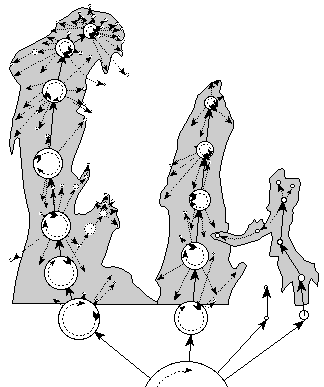
Diagram of how decaying balls-of-light produced the towers. Note: the balls-of-light depicted in this diagram are inflated in size to make them easier to depict.
Left Tower of M16
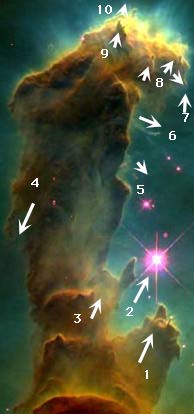
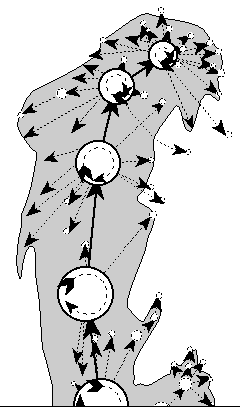
Left Tower of M16
Details:
- Note how this area appears to moving up and to the right. If this is the case, as follow-up images will prove or disprove, then this would correlate to the Ball-of-Light Particle Model and not to traditional astrophysical theory. Note, the small bright spots at the ends of the nubbins. These are decaying balls-of-light.
- Again, note the apparent motion and the brighter spot on the end of the nubbin.
- Again, note the apparent motion.
- One current theory states that bright stars above and to the right are burning off a cloud of dust and gas. If so, why is the protrusion located on the backside, apparently moving down and to the left?
- Between the number 5 and its arrow is a small, misty looking protrusion from an apparent decaying ball-of-light. I believe enlargements of this an other similar structures will look like the decaying balls-of-light in the Helix Nebula.
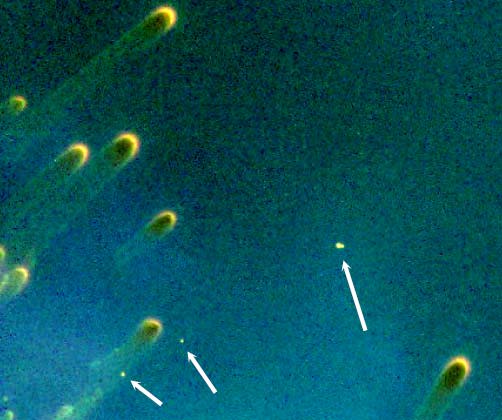
- To the left of the number 6, and below its associated arrow is a slightly larger trail left by an apparent decaying ball-of-light.
- Nubbin with ball-of-light on end.
- Nubbins with ball-of-light on ends.
- Nubbin with ball-of-light on end.
- Nubbin with ball-of-light on end.
Top of Left Tower of M16
An enlargement of the top of the upper left tower shows some of these features in much clearer detail.
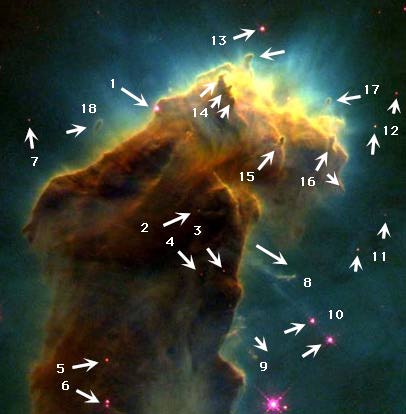
Top of Left Tower of M16
Details:
- This is a critical detail. Note the decaying ball-of-light. This is not a background star since it lies in front of the tower and is relatively small.
- Another ball-of-light.
- Another ball-of-light.
- Another ball-of-light.
- Another ball-of-light.
- Two more balls-of-light.
- Another ball-of-light.
- Dust trail from a decaying ball-of-light.
- Another dust trail from a decaying ball-of-light.
- Two more ejected balls-of-light.
- Two more balls-of-light.
- Two more balls-of-light.
- A star or another ball-of-light.
- Four nubbins of dust created by decaying balls-of-light.
- Another nubbin of dust.
- Two more nubbin dust trails left by decaying balls-of-light.
- Another dust trail left by a decaying ball-of-light.
- Another dust trail left by a decaying ball-of-light.
Predictions about the Towers of M16
This will be decided very easily and obviously -- and very soon. (I am writing this on 6/23/98 -- 4:17 AM) I am not yet aware of any new Hubble Space Telescope images of this type -- but I predict they soon will be either taken, or they have been taken and will soon be made public. The Ball-of-Light Particle Model predicts the infrared camera -- NICMOS -- on the HST will "discover" bright "star-like" objects in the center of these columns of dust. Scientists who take these images will be "amazed" or possibly "surprised" that "stars are forming" in these columns, and that they must be made "somehow" by "shock waves" propagating through the columns.
The Towers of M16 are made by decaying balls-of-light. Some of these balls-of-light are decaying in the "fizzle" mode. Some are surely decaying explosively. (X-Ray images should reveal bright spots.)
(5/7/2003 Prediction comes true. Today I was checking for websites that might have thermal images of the Towers of M16 in order to prove that they have decaying balls-of-light inside the heads of the towers. It turns out I am correct. See this website.)





